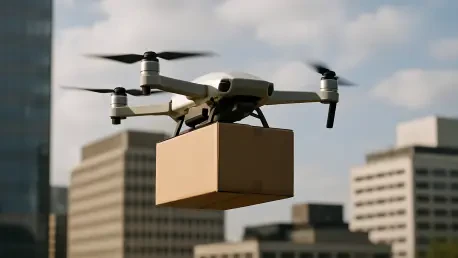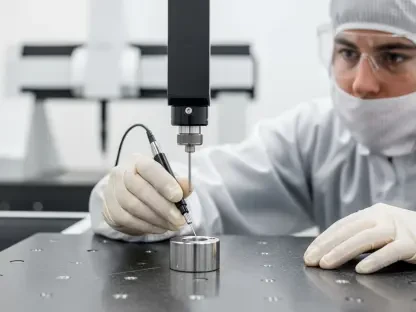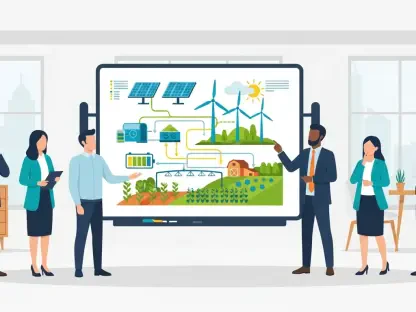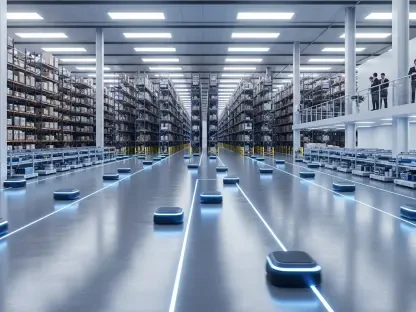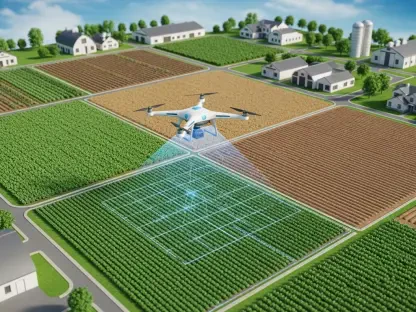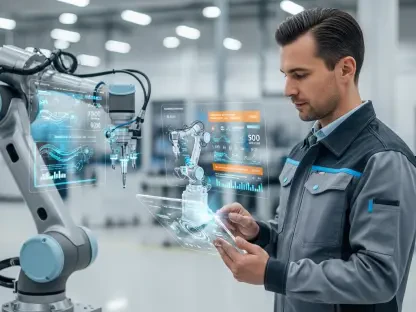Imagine a world where a pint of ice cream arrives at your doorstep in under 30 minutes, untouched by traffic delays and delivered straight from the sky. This is no longer a distant dream but a growing reality in select American neighborhoods, thanks to delivery drone technology. As logistics races to meet the demands of instant gratification in e-commerce, drones are emerging as a game-changer for last-mile delivery, promising speed and efficiency. This review dives deep into the current state of this innovative technology, exploring its core features, real-world applications, and the hurdles it must overcome to become a household norm.
Understanding Delivery Drone Systems
Delivery drones are transforming the logistics landscape by tackling the inefficiencies of last-mile delivery, a segment notorious for high costs and delays. Designed to transport small, lightweight packages directly to consumers, these unmanned aerial vehicles prioritize rapid service, often completing deliveries in a fraction of the time taken by traditional methods. Their emergence aligns with the booming e-commerce sector, where customer expectations for same-day or even same-hour delivery continue to soar.
At the heart of this technology lie sophisticated components such as electric propulsion systems for flight, advanced navigation software for precise routing, and payload mechanisms to securely carry goods. These elements work together to ensure drones can operate autonomously, dodging obstacles and landing with pinpoint accuracy. The basic framework, while compact, is engineered for reliability under varying conditions, a critical factor for scaling operations.
The journey of drone delivery in the U.S. has been marked by a cautious pace, initially hindered by stringent regulatory frameworks and operational complexities. Despite early international successes in places like Rwanda and Australia, adoption here faced barriers, including safety concerns and airspace management issues. However, recent strides by major corporations and evolving policies signal a shift, positioning drones as a vital cog in the modern supply chain.
Technical Breakdown and Capabilities
Navigation and Autonomous Flight
Central to a delivery drone’s functionality is its ability to navigate complex environments without human intervention. Leveraging GPS technology, onboard cameras, and cutting-edge algorithms, these systems enable autonomous flight, adeptly avoiding obstacles like trees or power lines. Such precision ensures that packages reach their destinations without detours or mishaps, a key metric of operational success.
A pivotal advancement in this domain is the development of beyond-visual-line-of-sight (BVLOS) capabilities, allowing drones to operate over extended distances without constant operator oversight. This feature dramatically expands their range, making deliveries to remote or suburban areas feasible. Real-world tests have demonstrated high accuracy in navigation, with many models achieving near-perfect drop-off rates in controlled environments.
Performance metrics further underscore the reliability of these systems, with ongoing trials refining response times and error margins. As regulatory bodies like the FAA propose rules to ease BVLOS restrictions, the potential for drones to cover vast regions without individual waivers grows. This evolution marks a significant leap toward integrating drones into mainstream logistics networks.
Payload Design and Capacity Limits
The design of payload systems in delivery drones focuses on balancing weight constraints with practical utility. Most current models are equipped to carry loads between 2.5 and 4 pounds, suitable for small items like food orders, medical supplies, or personal care products. Delivery mechanisms, often involving winches or drop-off compartments, ensure safe and contactless handovers to customers.
These capacity limits shape the scope of items drones can transport, often restricting them to lightweight, high-priority goods. For instance, delivering a carton of eggs or a prescription fits within their capabilities, while bulkier items remain the domain of ground vehicles. This constraint highlights a niche role for drones, catering to urgent or small-scale needs rather than comprehensive delivery solutions.
Innovations in payload design are pushing these boundaries, with companies like Amazon engineering models to handle slightly heavier loads through enhanced structural designs. Such advancements aim to broaden the range of deliverable goods, addressing a key limitation. As testing continues, the industry is keenly focused on optimizing these systems to maximize efficiency without compromising safety.
Latest Advancements in the Field
The landscape of drone delivery has seen remarkable progress in recent times, driven by both technological innovation and policy shifts. Proposed FAA rule changes to permit BVLOS flights without individual waivers stand as a cornerstone development, poised to unlock longer-range operations. This regulatory pivot is crucial for scaling services to reach millions of households across diverse terrains.
Corporate giants are also fueling momentum, with entities like Walmart, Amazon, and DoorDash expanding their drone programs through partnerships with operators such as Wing and Zipline. Their focus on suburban and rural markets addresses accessibility gaps, bringing convenience to areas underserved by traditional delivery infrastructure. Walmart, for instance, aims to extend coverage to numerous stores across multiple states within the next couple of years.
Emerging trends point to deeper integration of drones into everyday logistics networks, with an emphasis on seamless coordination with existing systems. This includes syncing drone deliveries with ground-based operations to optimize efficiency. As these initiatives unfold, the technology is steadily carving a space within the broader delivery ecosystem, setting the stage for widespread adoption.
Practical Deployments and Impact
In real-world settings, delivery drones are already making their mark, particularly in select U.S. regions where pilot programs have taken flight. Walmart’s extensive operations, boasting over 150,000 deliveries of everyday items like ice cream and candy, exemplify the technology’s potential to handle routine consumer needs. Such deployments highlight drones’ ability to offer rapid service in controlled environments.
Specific industries are reaping significant benefits, with e-commerce, food delivery, and healthcare at the forefront. Partnerships, such as DoorDash collaborating with drone operators, have enabled swift transport of restaurant orders, enhancing customer satisfaction. Similarly, medical supply transport via drones has proven invaluable, especially in urgent scenarios where time is critical, demonstrating versatility across sectors.
Unique applications further showcase the technology’s reach, such as improving access in rural communities where traditional delivery is slow or impractical. Drawing inspiration from international models in Rwanda and Australia, where drones have normalized medical and consumer deliveries, U.S. implementations are adapting lessons learned to local contexts. These cases underscore the transformative impact drones can have on bridging logistical gaps.
Barriers and Constraints
Despite the promise, delivery drones face substantial operational challenges that temper their growth. High costs remain a primary concern, with each delivery averaging around $13.50 compared to just $2 for vehicle-based methods. This economic disparity poses a hurdle to scalability, requiring significant investment to bring expenses down through technological refinement.
Technical limitations also persist, notably in payload restrictions that confine drones to smaller loads, and vulnerabilities to adverse weather conditions like strong winds or rain. Safety risks, including the potential for mid-air collisions or system failures, add another layer of complexity. These issues necessitate robust safeguards and continuous improvements to ensure reliability in diverse scenarios.
Regulatory and societal barriers further complicate the landscape, as historically strict FAA rules have limited operational freedom, though recent proposals aim to address this. Community concerns, such as privacy fears from onboard cameras and noise disturbances, also linger, prompting companies to develop quieter designs and transparent policies. Balancing safety, scalability, and public acceptance remains an ongoing endeavor for the industry.
Prospects on the Horizon
Looking ahead, the trajectory of delivery drone technology appears promising, with anticipated reductions in operational costs through economies of scale and enhanced designs. Technological advancements are expected to bolster payload capacities and weather resilience, addressing current shortcomings. These improvements could redefine the scope of drone applications in logistics over the coming years.
Regulatory progress, especially around BVLOS operations, holds the key to unlocking large-scale deployment, potentially serving millions more households. As frameworks evolve to prioritize both safety and innovation, the industry stands to gain from streamlined approvals and broader operational mandates. This shift could catalyze a new era of aerial delivery integration.
Long-term implications suggest that drones will likely complement rather than replace human drivers, focusing on niche, high-speed deliveries while traditional methods handle bulkier goods. Their role in sustainable logistics, reducing emissions compared to vehicle fleets, also positions them as a green alternative. The future envisions a hybrid model where drones and ground systems coexist to optimize efficiency and environmental impact.
Final Reflections
Reflecting on the journey of delivery drone technology, it is evident that gradual strides have been made, transforming a once-niche concept into a tangible solution in American neighborhoods. The blend of speed and reduced environmental footprint stands as a notable strength, though high costs and public skepticism present persistent challenges. Assessing the overall landscape, the technology shows immense potential tempered by practical hurdles.
Moving forward, stakeholders need to prioritize cost-effective innovations and robust safety protocols to enhance viability. Collaborative efforts between regulators and industry players are essential to refine policies that support scalability without compromising security. Additionally, addressing community concerns through quieter designs and clear communication about privacy safeguards emerges as a critical step to foster acceptance.
The path ahead demands a focus on integrating drones into existing logistics frameworks as complementary tools, ensuring they enhance rather than disrupt current systems. Investment in public education about the benefits and limitations of this technology could further smooth its adoption. Ultimately, the successful evolution of drone delivery hinges on striking a balance between cutting-edge advancements and societal readiness, paving the way for a redefined logistics future.
